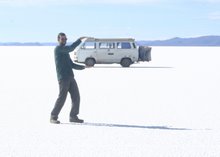We went first to Chucuito, which is famous for its Temple of Fertility. As soon as the taxi pulled into the central square of the sleepy little town, two small kids approached and offered to be our guides. They of course had finger puppets on, hoping to make a sale. They were quite the young entrepreneurs, and even had a sales pitch worked up where they spoke in unison in sing-song voices. We were a little weirded out at the thought of having the Temple of Fertility explained to us by 5-year olds, but decided that they were old pros, and so we hired them.

The Temple is an old Inca site where women would come to make offerings of coca, hoping the gods would favor them with children. The central part of the temple, which no longer has a roof, is filled with carved stone phalluses, some as big as 4 feet! The older guide told us most of the story, then poked his business partner in the side to get her attention, and they ended by saying “and that concludes the story of the Temple of Fertility” in unison. They were pretty cute. When we paid them, we asked them who got to keep the money, and they said it all went straight to their mother, so we paid them with some chocolate, as well.

On our way back to Puno, we stopped at the tiny lakeside village of Chimu, where they are famous for making the reed boats. It must have been the wrong season or day, because we didn’t see any boat building, only reed-drying. Luckily, there was one small house that doubled as a museum and boat souvenir store, so we stopped. We first looked around the museum, where they had a spectacular collection of replicas of local birds and animals, and a large reed boat carrying the Inca King and his wife. It was pretty impressive, so we resolved to buy a small boat or two.
When we went downstairs, some of the boatmakers came out of their boatmaking room/living room to answer our questions, and to ask questions of their own about where we are from, what it’s like, etc. It turned out that one of the boatmakers was also a boat racer, who regularly takes part in (and wins!) the annual reed boat race on October 22.
The next day we took a guided tour out to the floating islands. The boat was typical for here, and only had one speed. When they wanted to start or stop it, the captain would leave the wheel and head to the back of the boat, lift a wooden cover on a hatch, and fiddle with the engine. Typical, yes. Safe, maybe not.
We arrived on the floating islands to see a veritable army of locals ready to greet us and sell us things. Our tour group sat in a semicircle to listen to the story of the floating islands, and to taste totora, the reed used to build both the boats and the islands. How multipurpose can you get?

Totora is extremely rich in fluoride; here is a picture of Douglas and Beulah getting a full day's worth of fluoride in one bite:

The folks who built the Uros Islands speak Aymara, a different language from most of the indigenous people in Peru, who speak Quechua. They are originally from the Amazon Basin, if I’m remembering correctly. They were persecuted by other nations in the area, and began living on floating islands to evade conflict with their neighbours.
The islands are built by first cutting free a big mat of entwined totora roots from the edge of the lake. This mat floats to the top, and successive layers of totora reeds are laid on top. Every so often (depending on the season, as often as once a week) new reeds are laid down. After 20 years or so, the islands are so thick that they touch the bottom and have to be abandoned because of danger of flooding in the rainy season.
The boats are built out of totora reeds, as well. Originally they were made of pure totora reeds, and would only last for 3 months. Nowadays, though, the builders incorporate layers of plastic bottles, and the boats last for 2.5 years.

Overall, the visit to the islands was a bit of a mixed bag, and we have debated a fair amount about what to make of it. On the one hand, it was incredibly touristy, almost Disneyfied. Each island was essentially a floating souvenir shop, and we felt not just that these folks’ lives were impacted by the tourist trade, but that their lives were shaped by and for the tourist trade and almost nothing else. They were like a living museum exhibit.


On the other hand, they have found a way to preserve their unique way of life. Their community seemed fairly intact, and we didn’t get the impression that many families were split up because the husband (and maybe the kids, too) had left to work in a big city. They also seemed to be doing fairly well. The proceeds from the tourist visits are shared among the community, and have been used to build a big school, and to provide amenities like solar panels and international telephones on the island. In that respect, at least, the development was positive – the money is really going back to the community, and is being used productively.

Still, I don’t know if I would want to live in Disneyland, even if there were solar panels and good schools.
Enough seriousness - here is a video of a trici-taxi ride we took on our way to eat delicious cake in Puno. And a photo of the trici-taxis, which are quite common, and very fast!!


No comments:
Post a Comment